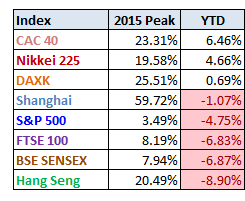All eight indexes on our world watch finished in the green this past week, a complete reversal of the eight-down last week, although the collective gain was less than half the previous week's decline. Hong Kong's Hang Seng was the top performer, with its 3.18% gain. The three European indexes had the smallest gains, with France's CAC 40's 0.57% at the bottom of the list.
Here is an overlay of the eight for a sense of their comparative performance so far in 2015.

As for the Shanghai selloff in recent weeks, below is a log-scale weekly chart illustrating the bubble that peaked in 2007 and the rally that started last year. The index is now down -38.1% off its June 12 peak but off its -43.3% interim low set on July 8th.


Here is a table of the 2015 data performance, sorted from high to low, along with the interim highs for the eight indexes. Five of the eight are now in the red YTD, down from six last week. The DAX being the one that has vacillated around the flat line.
A Closer Look at the Last Four Weeks
The tables below provide a concise overview of performance comparisons over the past four weeks (through year's end) for these eight major indexes. We've also included the average for each week so that we can evaluate the performance of a specific index relative to the overall mean and better understand weekly volatility. The colors for each index name help us visualize the comparative performance over time.

The chart below illustrates the comparative performance of World Markets since March 9, 2009. The start date is arbitrary: The S&P 500, CAC 40 and BSE SENSEX hit their lows on March 9th, the Nikkei 225 on March 10th, the DAX on March 6th, the FTSE on March 3rd, the Shanghai Composite on November 4, 2008, and the Hang Seng even earlier on October 27, 2008. However, by aligning on the same day and measuring the percent change, we get a better sense of the relative performance than if we align the lows.
A Longer Look Back
Here is the same chart starting from the turn of the 21st century. The relative over-performance of the emerging markets (Shanghai, Mumbai SENSEX and Hang Seng) up to their 2007 peaks is evident, and the SENSEX remains by far the top performer. The Shanghai, in contrast, formed a perfect Eiffel Tower from late 2006 to late 2009.
Note: We track Germany's DAXK a price-only index, instead of the more familiar DAX index (which includes dividends), for consistency with the other indexes, which do not include dividends.
All the indexes are calculated in their local currencies.


